Abstract
The process of continuous ambulatory peritoneal dialysis has provided a useful, relatively inexpensive, and safe alternative for patients with end-stage renal disease. Infectious peritonitis, however, has limited a more widespread acceptance of this technique. The definition of peritonitis in this patient population is not universally accepted and does not always include the laboratory support of a positive culture (or Gram stain). In part, the omission of clinical microbiological findings stems from the lack of sensitivity of earlier microbiological efforts. Peritonitis results from decreased host phagocytic efficiency with depressed phagocytosis and bactericidal capacity of peritoneal macrophages. During episodes of peritonitis, fluid movement is reversed, away from the lymphatics and peritoneal membrane and toward the cavity. As a result, bloodstream infections are rare. Most peritonitis episodes are caused by bacteria. Coagulase-negative staphylococci are the most frequently isolated organisms, usually originating from the skin flora, but a wide array of microbial species have been documented as agents of peritonitis. Clinical microbiology laboratories need to be cognizant of the diverse agents so that appropriate primary media can be used. The quantity of dialysate fluid that is prepared for culture is critical and should constitute at least 10 ml. The sensitivity of the cultural approach depends on the volume of dialysate, its pretreatment (lysis or centrifugation), the media used, and the mode of incubation. The low concentration of microorganisms in dialysate fluids accounts for negative Gram stain results. Prevention of infection in continuous ambulatory peritoneal dialysis patients is associated with the socioeconomic status of the patient, advances in equipment (catheter) technology, and, probably least important, the application of prophylactic antimicrobial agents.
Full text
PDF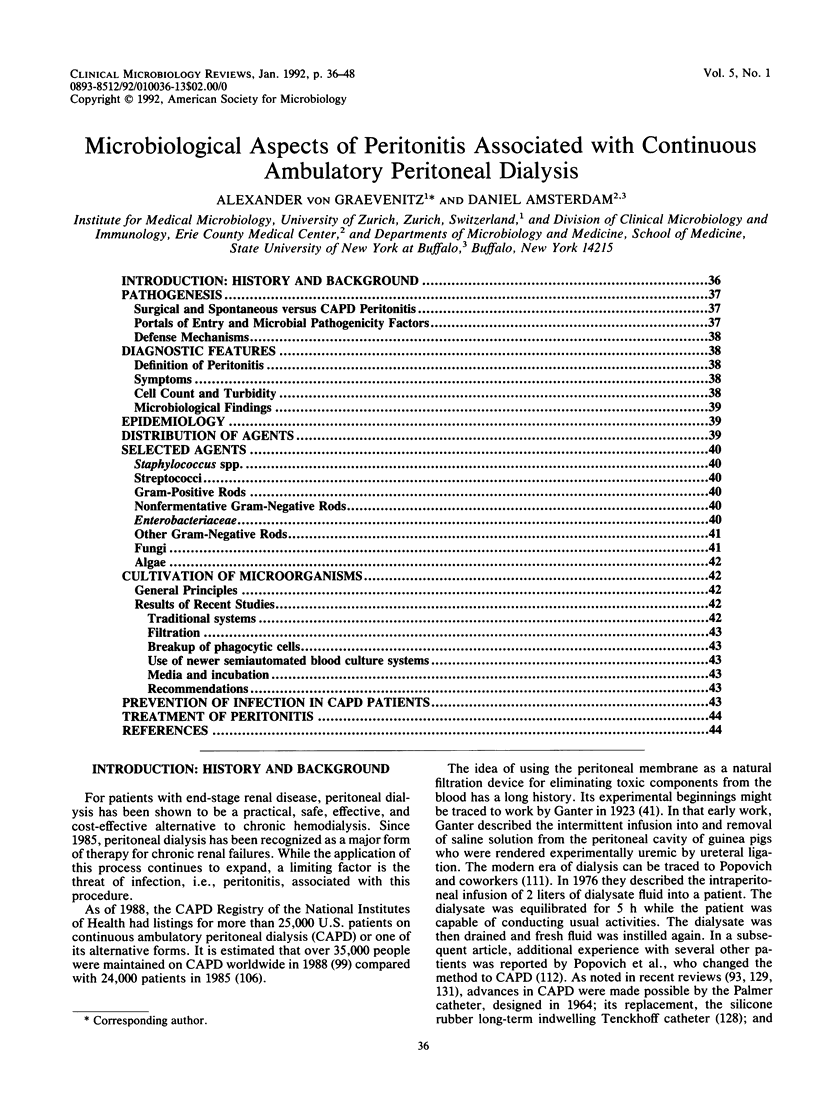
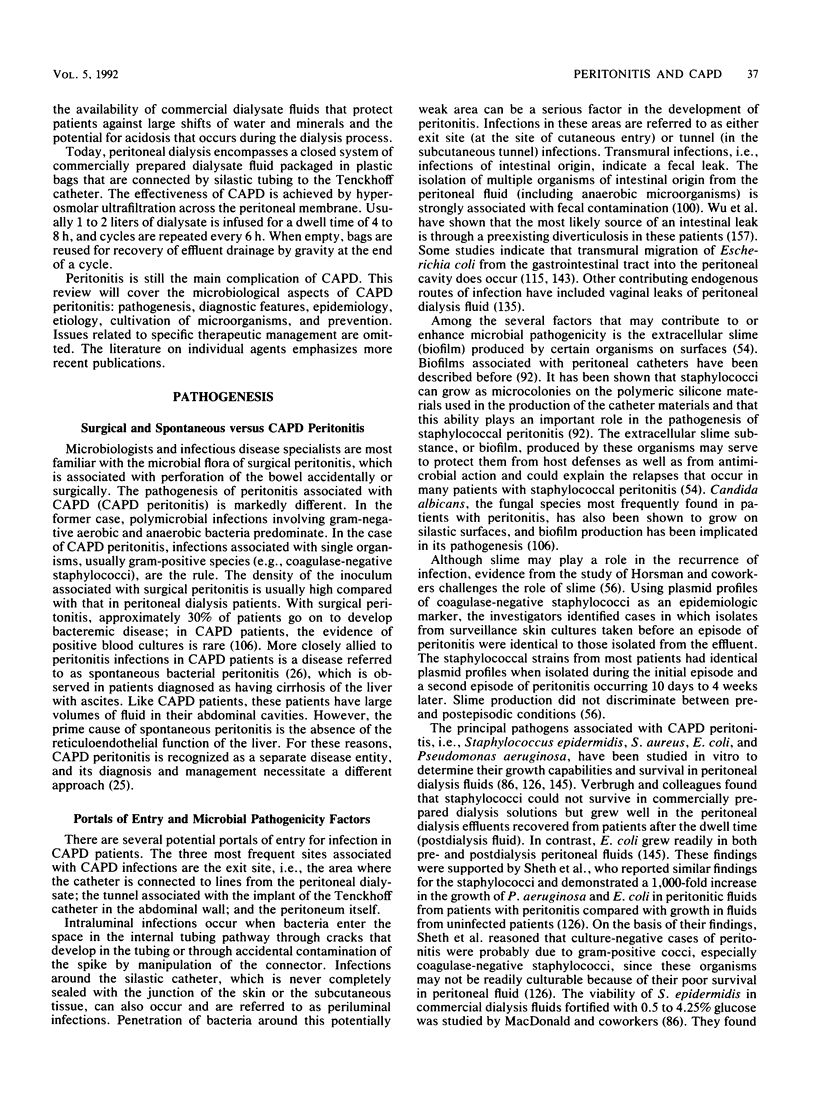
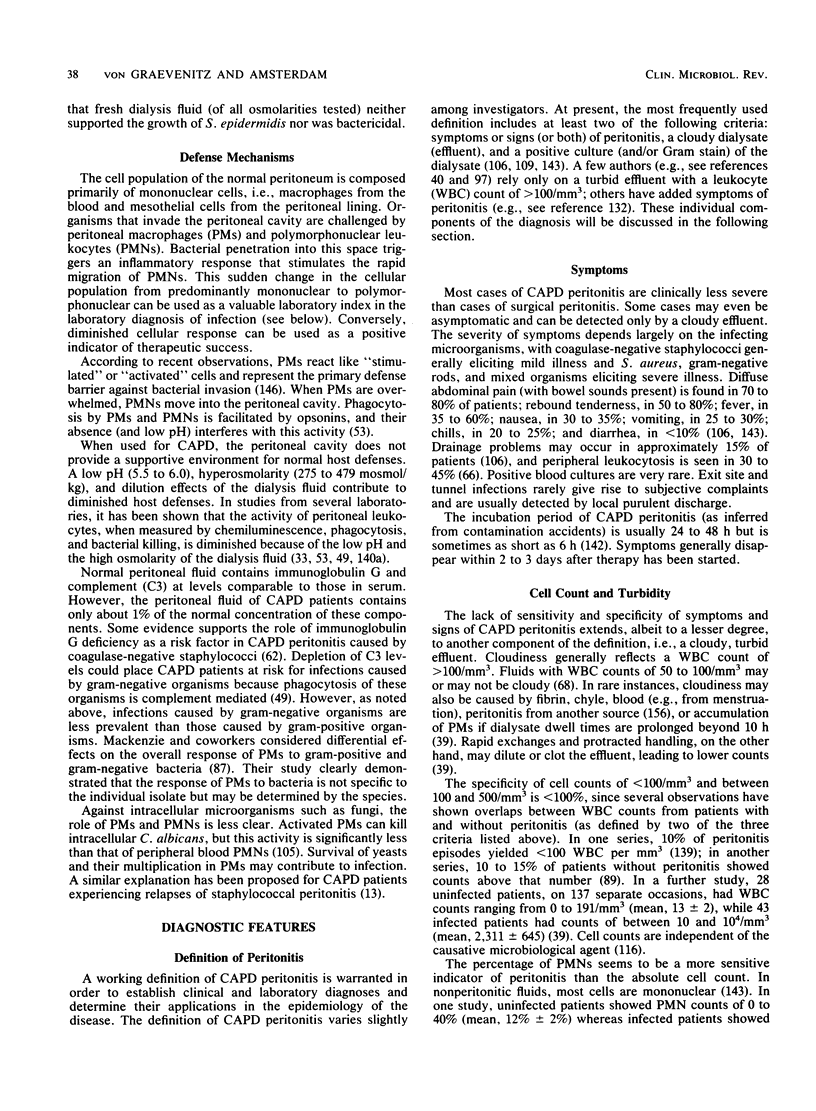
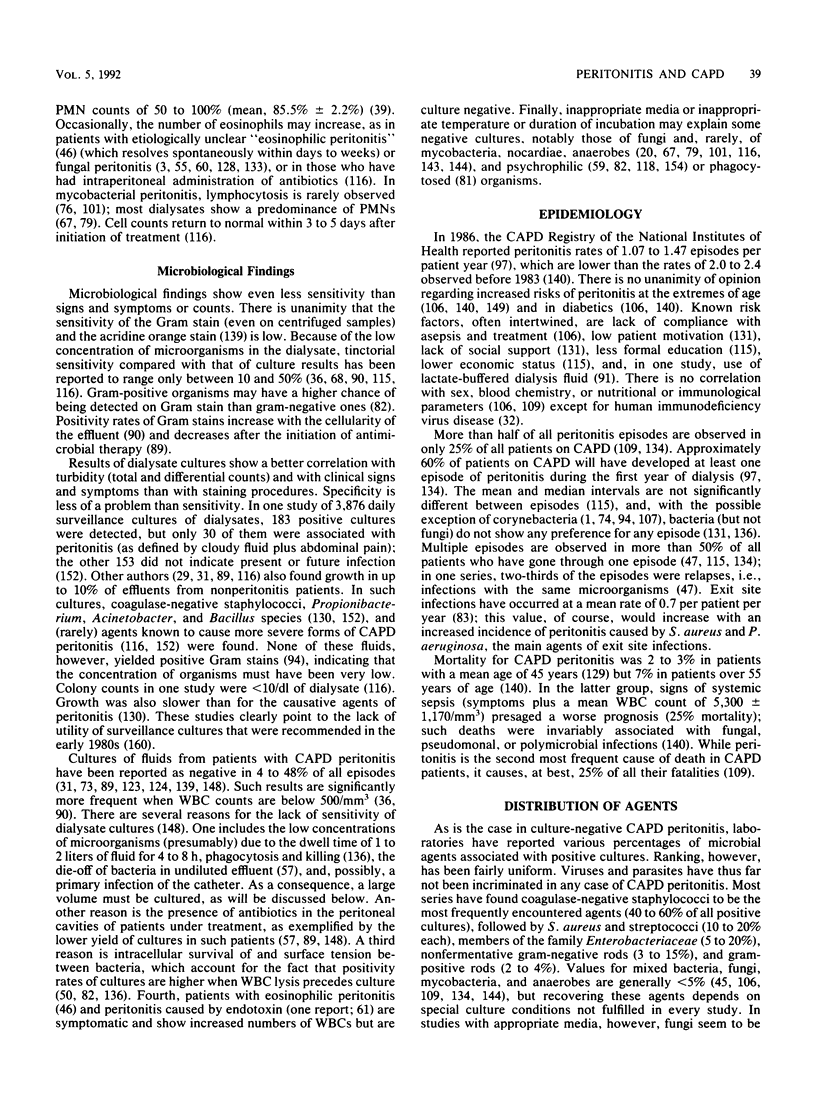
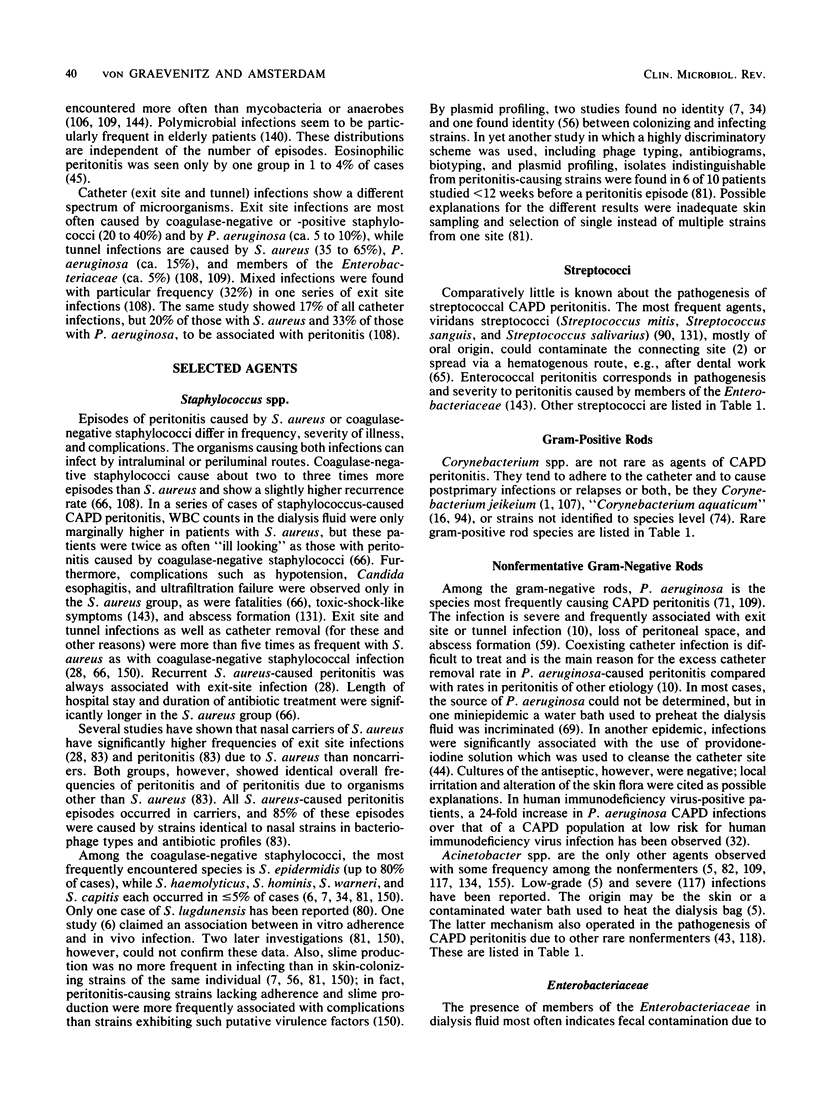
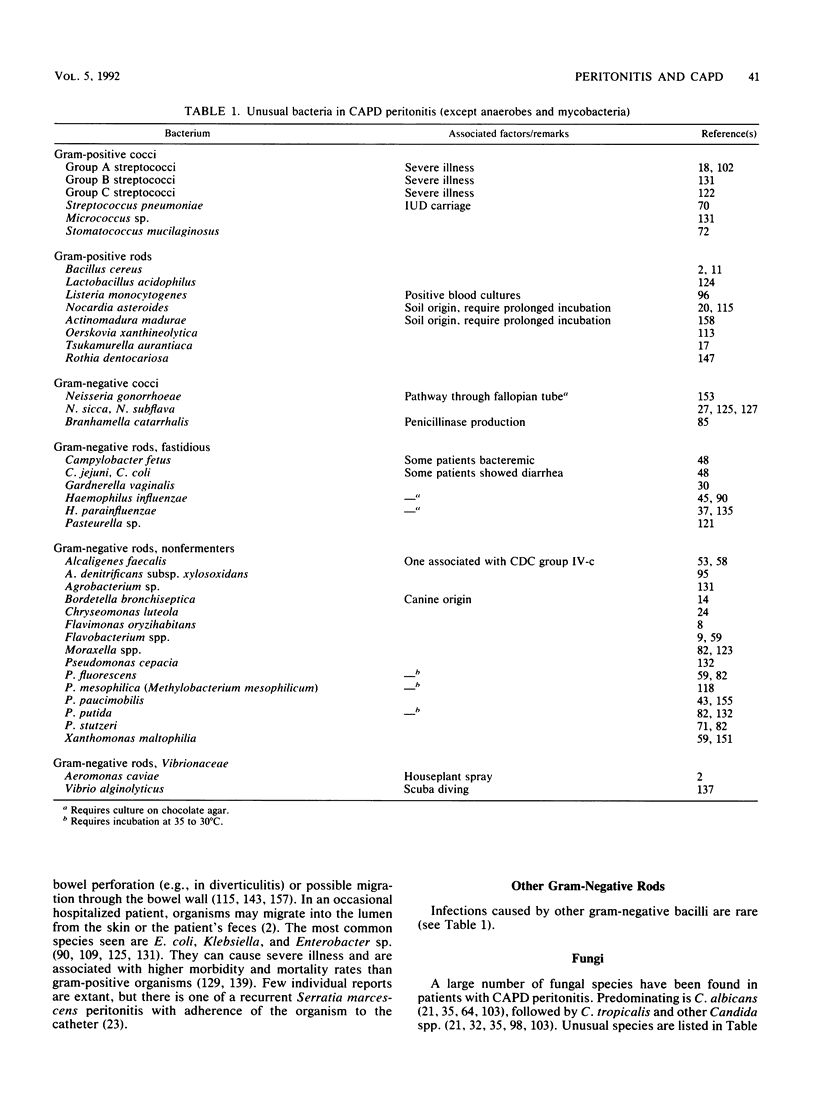
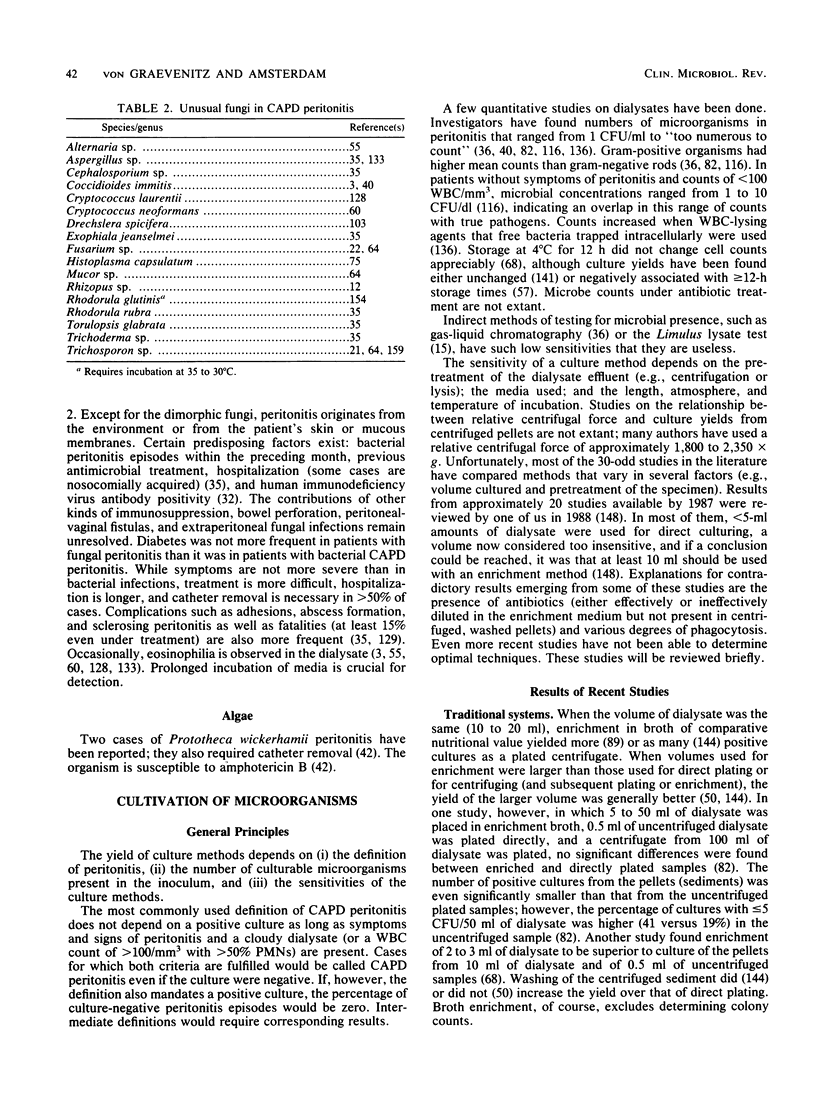
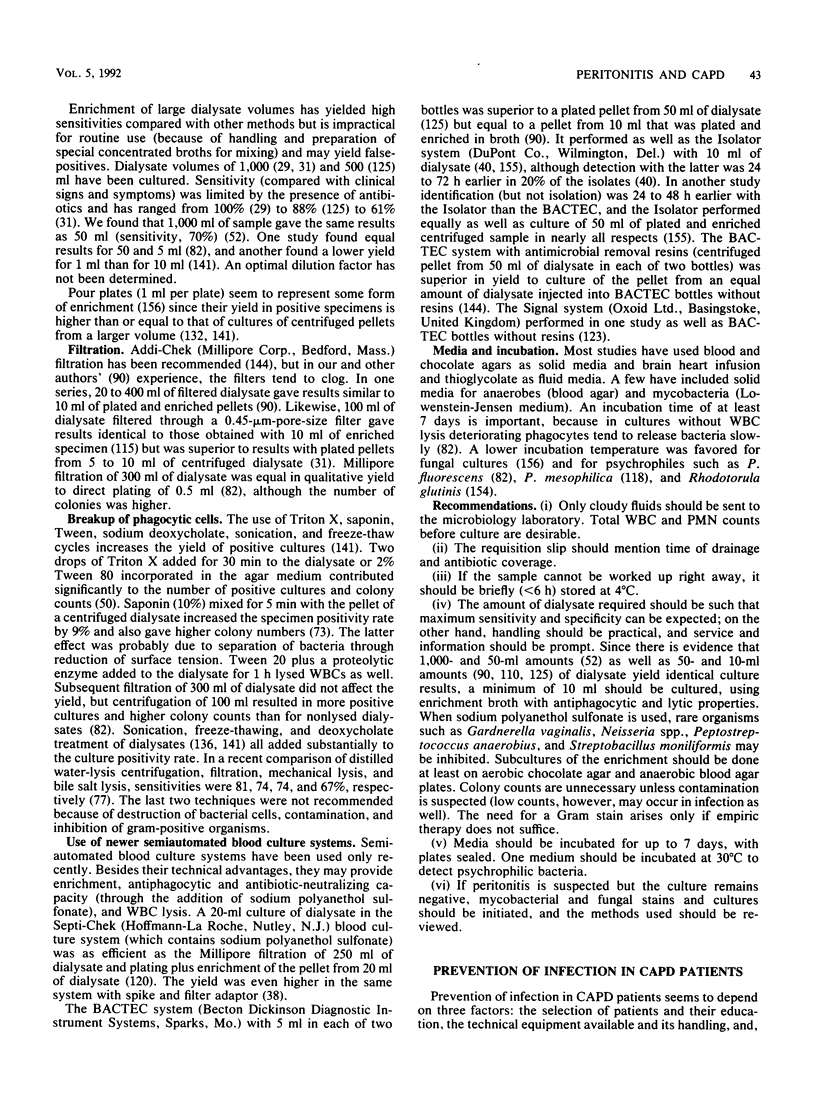
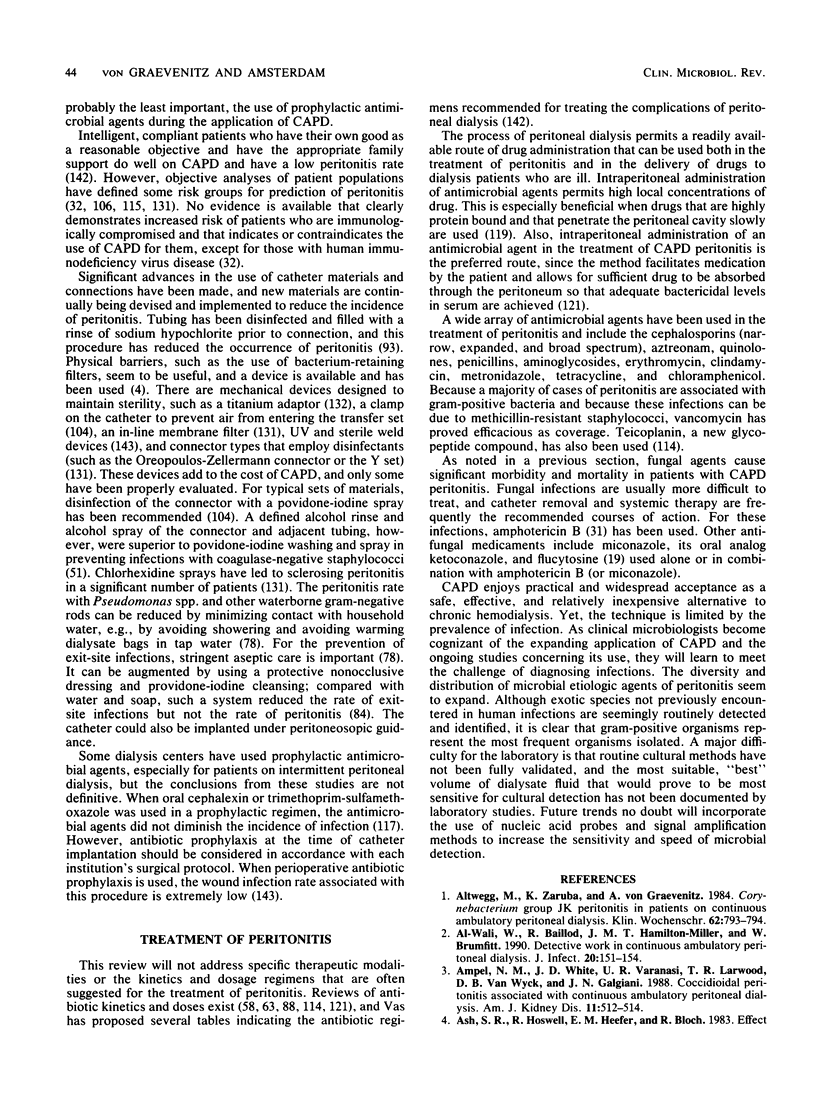
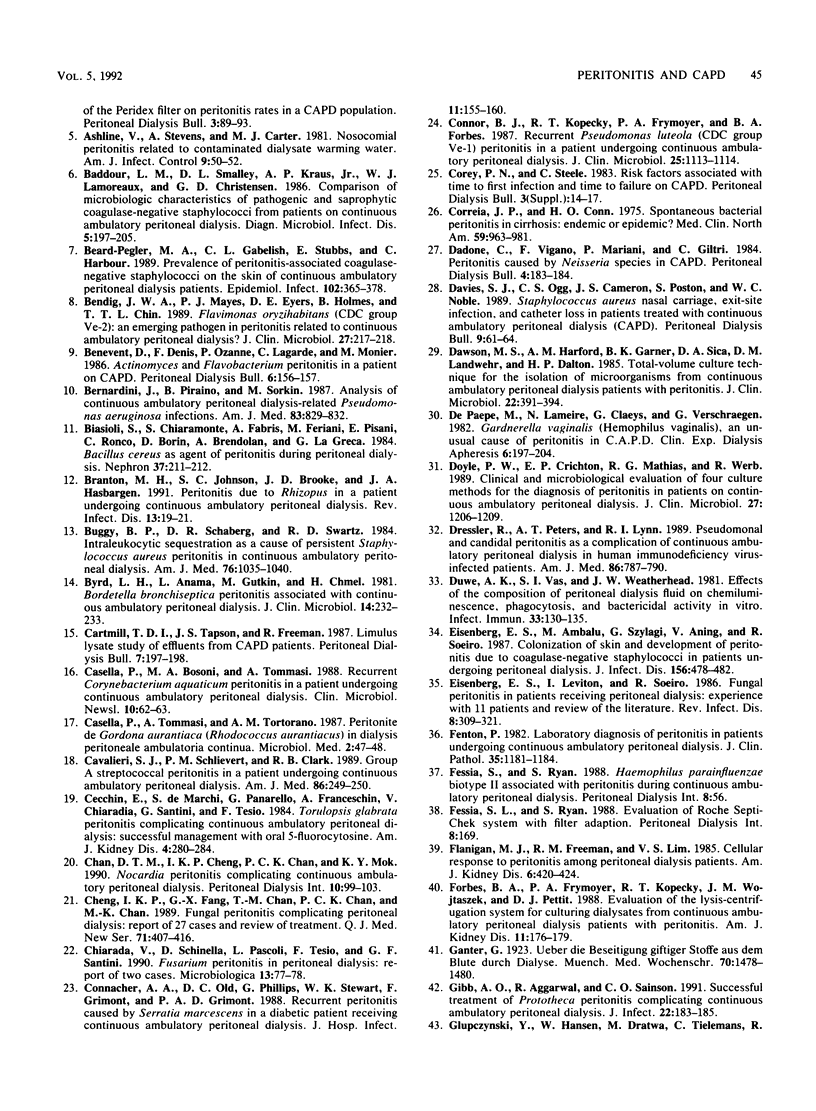
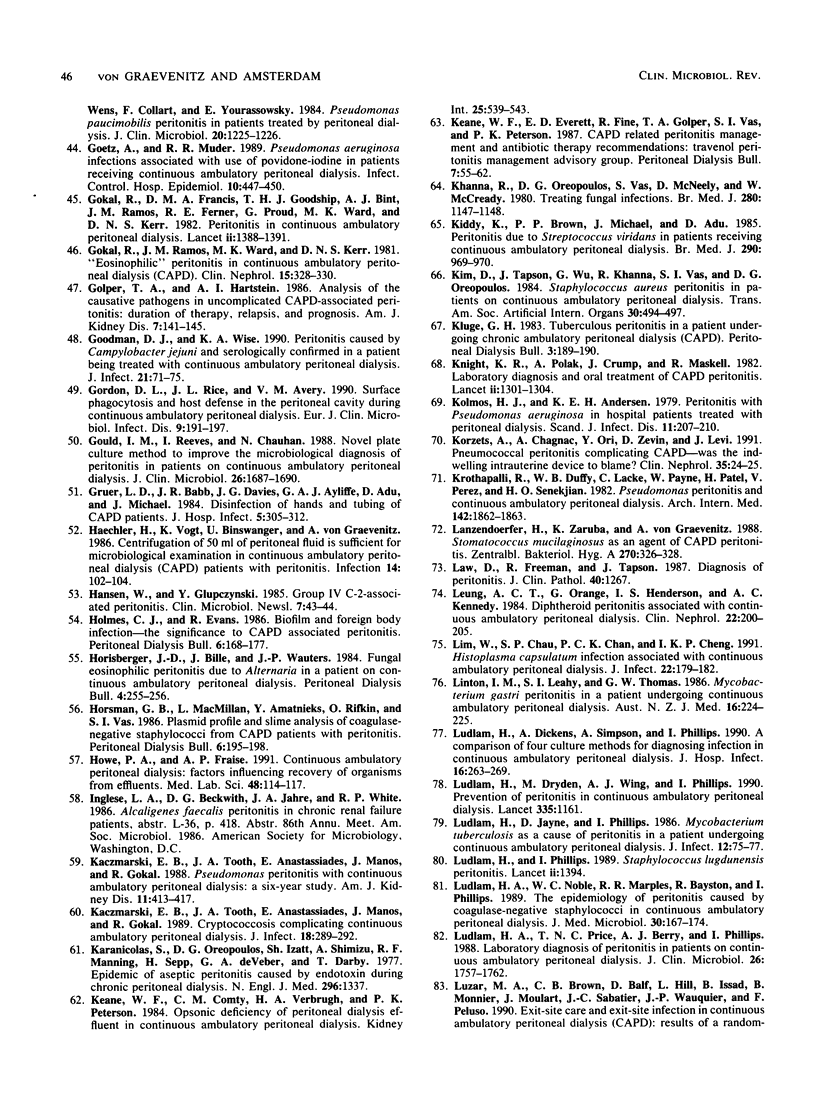
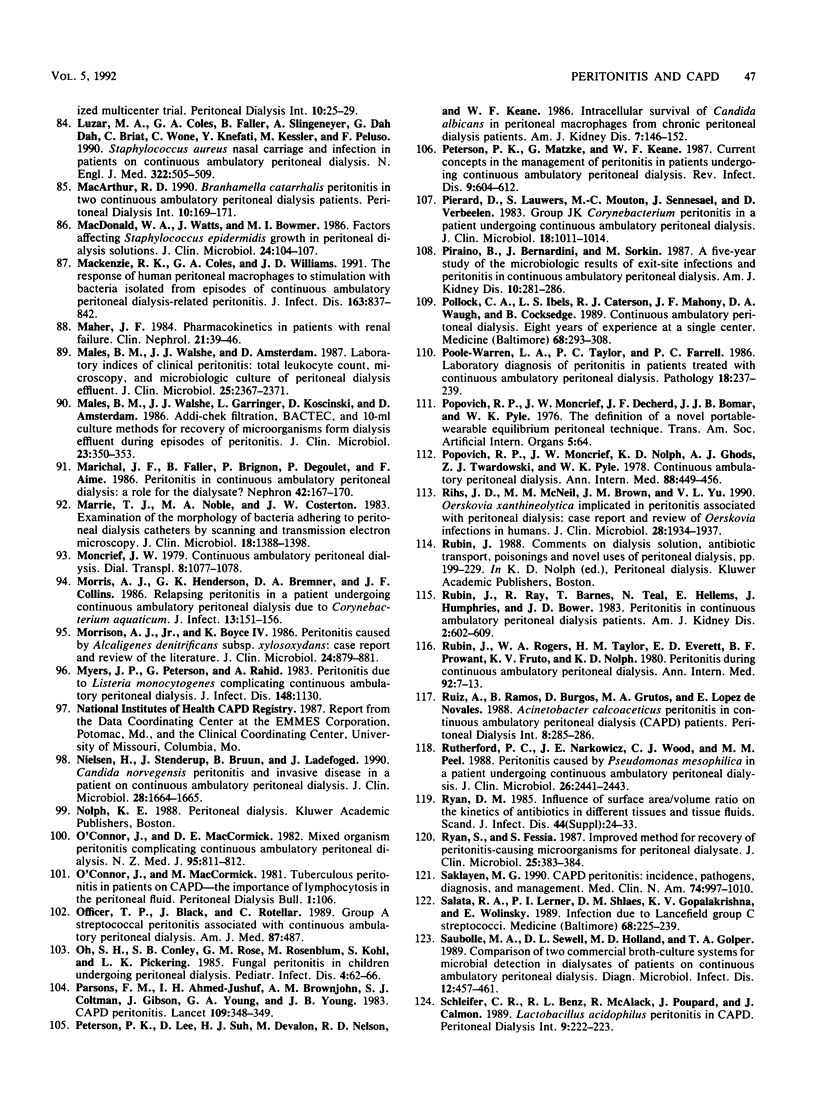
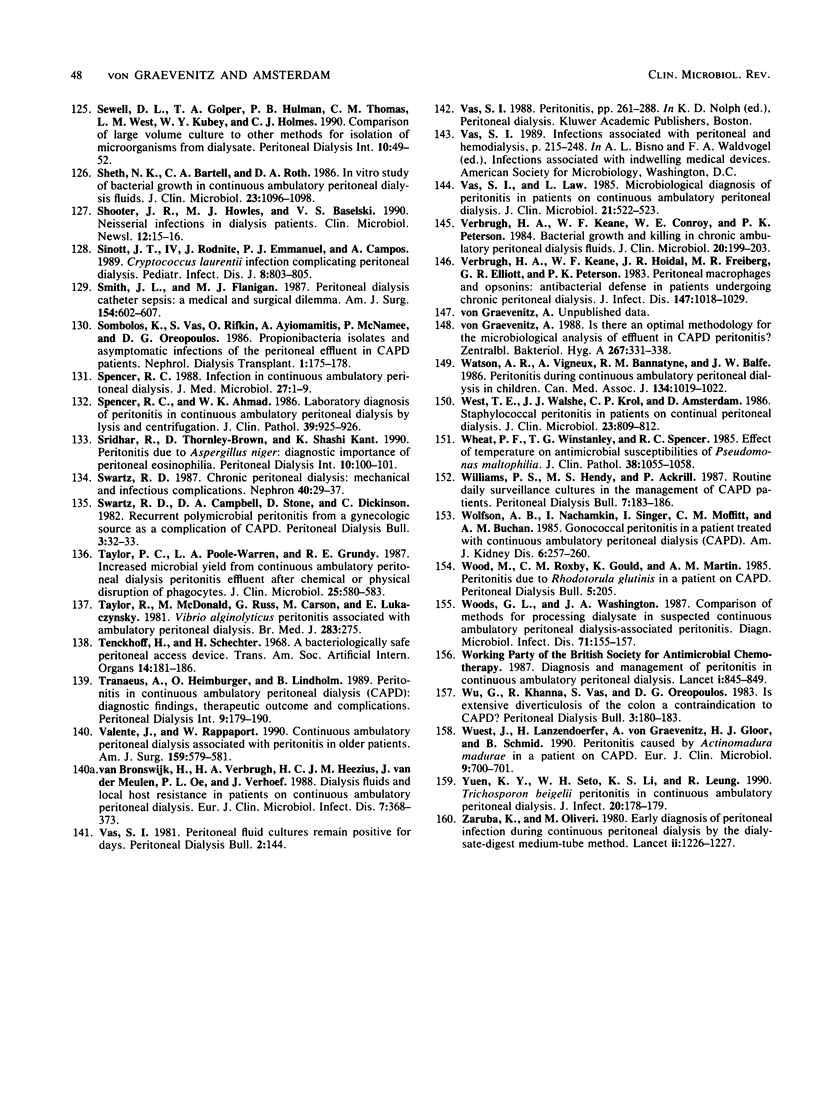
Selected References
These references are in PubMed. This may not be the complete list of references from this article.
- Altwegg M., Záruba K., von Graevenitz A. Corynebacterium group JK peritonitis in patients on continuous ambulatory peritoneal dialysis. Klin Wochenschr. 1984 Aug 16;62(16):793–794. doi: 10.1007/BF01721780. [DOI] [PubMed] [Google Scholar]
- Ampel N. M., White J. D., Varanasi U. R., Larwood T. R., Van Wyck D. B., Galgiani J. N. Coccidioidal peritonitis associated with continuous ambulatory peritoneal dialysis. Am J Kidney Dis. 1988 Jun;11(6):512–514. doi: 10.1016/s0272-6386(88)80088-x. [DOI] [PubMed] [Google Scholar]
- Ashline V., Stevens A., Carter M. J. Nosocomial peritonitis related to contaminated dialysate warming water. Am J Infect Control. 1981 May;9(2):50–52. doi: 10.1016/s0196-6553(81)80032-6. [DOI] [PubMed] [Google Scholar]
- Baddour L. M., Smalley D. L., Kraus A. P., Jr, Lamoreaux W. J., Christensen G. D. Comparison of microbiologic characteristics of pathogenic and saprophytic coagulase-negative staphylococci from patients on continuous ambulatory peritoneal dialysis. Diagn Microbiol Infect Dis. 1986 Sep;5(3):197–205. doi: 10.1016/0732-8893(86)90002-7. [DOI] [PubMed] [Google Scholar]
- Beard-Pegler M. A., Gabelish C. L., Stubbs E., Harbour C., Robson J., Falk M., Benn R., Vickery A. Prevalence of peritonitis-associated coagulase-negative staphylococci on the skin of continuous ambulatory peritoneal dialysis patients. Epidemiol Infect. 1989 Jun;102(3):365–378. doi: 10.1017/s0950268800030089. [DOI] [PMC free article] [PubMed] [Google Scholar]
- Bendig J. W., Mayes P. J., Eyers D. E., Holmes B., Chin T. T. Flavimonas oryzihabitans (Pseudomonas oryzihabitans; CDC group Ve-2): an emerging pathogen in peritonitis related to continuous ambulatory peritoneal dialysis? J Clin Microbiol. 1989 Jan;27(1):217–218. doi: 10.1128/jcm.27.1.217-218.1989. [DOI] [PMC free article] [PubMed] [Google Scholar]
- Bernardini J., Piraino B., Sorkin M. Analysis of continuous ambulatory peritoneal dialysis-related Pseudomonas aeruginosa infections. Am J Med. 1987 Nov;83(5):829–832. doi: 10.1016/0002-9343(87)90638-3. [DOI] [PubMed] [Google Scholar]
- Biasioli S., Chiaramonte S., Fabris A., Feriani M., Pisani E., Ronco C., Borin D., Brendolan A., La Greca G. Bacillus cereus as agent of peritonitis during peritoneal dialysis. Nephron. 1984;37(3):211–212. doi: 10.1159/000183247. [DOI] [PubMed] [Google Scholar]
- Branton M. H., Johnson S. C., Brooke J. D., Hasbargen J. A. Peritonitis due to Rhizopus in a patient undergoing continuous ambulatory peritoneal dialysis. Rev Infect Dis. 1991 Jan-Feb;13(1):19–21. doi: 10.1093/clinids/12.5.19. [DOI] [PubMed] [Google Scholar]
- Buggy B. P., Schaberg D. R., Swartz R. D. Intraleukocytic sequestration as a cause of persistent Staphylococcus aureus peritonitis in continuous ambulatory peritoneal dialysis. Am J Med. 1984 Jun;76(6):1035–1040. doi: 10.1016/0002-9343(84)90854-4. [DOI] [PubMed] [Google Scholar]
- Byrd L. H., Anama L., Gutkin M., Chmel H. Bordetella bronchiseptica peritonitis associated with continuous ambulatory peritoneal dialysis. J Clin Microbiol. 1981 Aug;14(2):232–233. doi: 10.1128/jcm.14.2.232-233.1981. [DOI] [PMC free article] [PubMed] [Google Scholar]
- Cavalieri S. J., Allais J. M., Schlievert P. M., Dworzack D. L., Clark R. B. Group A streptococcal peritonitis in a patient undergoing continuous ambulatory peritoneal dialysis. Am J Med. 1989 Feb;86(2):249–250. doi: 10.1016/0002-9343(89)90282-9. [DOI] [PubMed] [Google Scholar]
- Cecchin E., De Marchi S., Panarello G., Franceschin A., Chiaradia V., Santini G., Tesio F. Torulopsis glabrata peritonitis complicating continuous ambulatory peritoneal dialysis: successful management with oral 5-fluorocytosine. Am J Kidney Dis. 1984 Nov;4(3):280–284. doi: 10.1016/s0272-6386(84)80105-5. [DOI] [PubMed] [Google Scholar]
- Chan D. T., Cheng I. K., Chan P. C., Mok K. Y. Nocardia peritonitis complicating continuous ambulatory peritoneal dialysis. Perit Dial Int. 1990;10(1):99–99. [PubMed] [Google Scholar]
- Cheng I. K., Fang G. X., Chan T. M., Chan P. C., Chan M. K. Fungal peritonitis complicating peritoneal dialysis: report of 27 cases and review of treatment. Q J Med. 1989 May;71(265):407–416. [PubMed] [Google Scholar]
- Chiaradia V., Schinella D., Pascoli L., Tesio F., Santini G. F. Fusarium peritonitis in peritoneal dialysis: report of two cases. Microbiologica. 1990 Jan;13(1):77–78. [PubMed] [Google Scholar]
- Connacher A. A., Old D. C., Phillips G., Stewart W. K., Grimont F., Grimont P. A. Recurrent peritonitis caused by Serratia marcescens in a diabetic patient receiving continuous ambulatory peritoneal dialysis. J Hosp Infect. 1988 Feb;11(2):155–160. doi: 10.1016/0195-6701(88)90058-8. [DOI] [PubMed] [Google Scholar]
- Connor B. J., Kopecky R. T., Frymoyer P. A., Forbes B. A. Recurrent Pseudomonas luteola (CDC group Ve-1) peritonitis in a patient undergoing continuous ambulatory peritoneal dialysis. J Clin Microbiol. 1987 Jun;25(6):1113–1114. doi: 10.1128/jcm.25.6.1113-1114.1987. [DOI] [PMC free article] [PubMed] [Google Scholar]
- Correia J. P., Conn H. O. Spontaneous bacterial peritonitis in cirrhosis: endemic or epidemic? Med Clin North Am. 1975 Jul;59(4):963–981. doi: 10.1016/s0025-7125(16)31995-2. [DOI] [PubMed] [Google Scholar]
- Davies S. J., Ogg C. S., Cameron J. S., Poston S., Noble W. C. Staphylococcus aureus nasal carriage, exit-site infection and catheter loss in patients treated with continuous ambulatory peritoneal dialysis (CAPD). Perit Dial Int. 1989;9(1):61–64. [PubMed] [Google Scholar]
- Dawson M. S., Harford A. M., Garner B. K., Sica D. A., Landwehr D. M., Dalton H. P. Total volume culture technique for the isolation of microorganisms from continuous ambulatory peritoneal dialysis patients with peritonitis. J Clin Microbiol. 1985 Sep;22(3):391–394. doi: 10.1128/jcm.22.3.391-394.1985. [DOI] [PMC free article] [PubMed] [Google Scholar]
- De Paepe M., Lameire N., Claeys G., Verschraegen G. Gardnerella vaginalis (hemophilus vaginalis), an unusual cause of peritonitis in C.A.P.D. Clin Exp Dial Apheresis. 1982;6(4):197–204. doi: 10.3109/08860228209049852. [DOI] [PubMed] [Google Scholar]
- Doyle P. W., Crichton E. P., Mathias R. G., Werb R. Clinical and microbiological evaluation of four culture methods for the diagnosis of peritonitis in patients on continuous ambulatory peritoneal dialysis. J Clin Microbiol. 1989 Jun;27(6):1206–1209. doi: 10.1128/jcm.27.6.1206-1209.1989. [DOI] [PMC free article] [PubMed] [Google Scholar]
- Dressler R., Peters A. T., Lynn R. I. Pseudomonal and candidal peritonitis as a complication of continuous ambulatory peritoneal dialysis in human immunodeficiency virus-infected patients. Am J Med. 1989 Jun;86(6 Pt 2):787–790. doi: 10.1016/0002-9343(89)90474-9. [DOI] [PubMed] [Google Scholar]
- Duwe A. K., Vas S. I., Weatherhead J. W. Effects of the composition of peritoneal dialysis fluid on chemiluminescence, phagocytosis, and bactericidal activity in vitro. Infect Immun. 1981 Jul;33(1):130–135. doi: 10.1128/iai.33.1.130-135.1981. [DOI] [PMC free article] [PubMed] [Google Scholar]
- Eisenberg E. S., Ambalu M., Szylagi G., Aning V., Soeiro R. Colonization of skin and development of peritonitis due to coagulase-negative staphylococci in patients undergoing peritoneal dialysis. J Infect Dis. 1987 Sep;156(3):478–482. doi: 10.1093/infdis/156.3.478. [DOI] [PubMed] [Google Scholar]
- Eisenberg E. S., Leviton I., Soeiro R. Fungal peritonitis in patients receiving peritoneal dialysis: experience with 11 patients and review of the literature. Rev Infect Dis. 1986 May-Jun;8(3):309–321. doi: 10.1093/clinids/8.3.309. [DOI] [PubMed] [Google Scholar]
- Fenton P. Laboratory diagnosis of peritonitis in patients undergoing continuous ambulatory peritoneal dialysis. J Clin Pathol. 1982 Nov;35(11):1181–1184. doi: 10.1136/jcp.35.11.1181. [DOI] [PMC free article] [PubMed] [Google Scholar]
- Flanigan M. J., Freeman R. M., Lim V. S. Cellular response to peritonitis among peritoneal dialysis patients. Am J Kidney Dis. 1985 Dec;6(6):420–424. doi: 10.1016/s0272-6386(85)80105-0. [DOI] [PubMed] [Google Scholar]
- Forbes B. A., Frymoyer P. A., Kopecky R. T., Wojtaszek J. M., Pettit D. J. Evaluation of the lysis-centrifugation system for culturing dialysates from continuous ambulatory peritoneal dialysis patients with peritonitis. Am J Kidney Dis. 1988 Feb;11(2):176–179. doi: 10.1016/s0272-6386(88)80208-7. [DOI] [PubMed] [Google Scholar]
- Gibb A. P., Aggarwal R., Swainson C. P. Successful treatment of Prototheca peritonitis complicating continuous ambulatory peritoneal dialysis. J Infect. 1991 Mar;22(2):183–185. doi: 10.1016/0163-4453(91)91679-r. [DOI] [PubMed] [Google Scholar]
- Glupczynski Y., Hansen W., Dratwa M., Tielemans C., Wens R., Collart F., Yourassowsky E. Pseudomonas paucimobilis peritonitis in patients treated by peritoneal dialysis. J Clin Microbiol. 1984 Dec;20(6):1225–1226. doi: 10.1128/jcm.20.6.1225-1226.1984. [DOI] [PMC free article] [PubMed] [Google Scholar]
- Goetz A., Muder R. R. Pseudomonas aeruginosa infections associated with use of povidone-iodine in patients receiving continuous ambulatory peritoneal dialysis. Infect Control Hosp Epidemiol. 1989 Oct;10(10):447–450. doi: 10.1086/645919. [DOI] [PubMed] [Google Scholar]
- Gokal R., Ramos J. M., Francis D. M., Ferner R. E., Goodship T. H., Proud G., Bint A. J., Ward M. K., Kerr D. N. Peritonitis in continuous ambulatory peritoneal dialysis. Laboratory and clinical studies. Lancet. 1982 Dec 18;2(8312):1388–1391. doi: 10.1016/s0140-6736(82)91282-x. [DOI] [PubMed] [Google Scholar]
- Gokal R., Ramos J. M., Ward M. K., Kerr D. N. "Eosinophilic" peritonitis in continuous ambulatory peritoneal dialysis (CAPD). Clin Nephrol. 1981 Jun;15(6):328–330. [PubMed] [Google Scholar]
- Golper T. A., Hartstein A. I. Analysis of the causative pathogens in uncomplicated CAPD-associated peritonitis: duration of therapy, relapses, and prognosis. Am J Kidney Dis. 1986 Feb;7(2):141–145. doi: 10.1016/s0272-6386(86)80135-4. [DOI] [PubMed] [Google Scholar]
- Goodman D. J., Wise K. A. Peritonitis caused by Campylobacter jejuni and serologically confirmed in a patient being treated with continuous ambulatory peritoneal dialysis. J Infect. 1990 Jul;21(1):71–75. doi: 10.1016/0163-4453(90)90692-2. [DOI] [PubMed] [Google Scholar]
- Gordon D. L., Rice J. L., Avery V. M. Surface phagocytosis and host defence in the peritoneal cavity during continuous ambulatory peritoneal dialysis. Eur J Clin Microbiol Infect Dis. 1990 Mar;9(3):191–197. doi: 10.1007/BF01963836. [DOI] [PubMed] [Google Scholar]
- Gould I. M., Reeves I., Chauhan N. Novel plate culture method to improve the microbiological diagnosis of peritonitis in patients on continuous ambulatory peritoneal dialysis. J Clin Microbiol. 1988 Sep;26(9):1687–1690. doi: 10.1128/jcm.26.9.1687-1690.1988. [DOI] [PMC free article] [PubMed] [Google Scholar]
- Gruer L. D., Babb J. R., Davies J. G., Ayliffe G. A., Adu D., Michael J. Disinfection of hands and tubing of CAPD patients. J Hosp Infect. 1984 Sep;5(3):305–312. doi: 10.1016/0195-6701(84)90080-x. [DOI] [PubMed] [Google Scholar]
- Howe P. A., Fraise A. P. Continuous ambulatory peritoneal dialysis: factors influencing recovery of organisms from effluents. Med Lab Sci. 1991 Apr;48(2):114–117. [PubMed] [Google Scholar]
- Hächler H., Vogt K., Binswanger U., von Graevenitz A. Centrifugation of 50 ml of peritoneal fluid is sufficient for microbiological examination in continuous ambulatory peritoneal dialysis (CAPD) patients with peritonitis. Infection. 1986 May-Jun;14(3):102–104. doi: 10.1007/BF01643471. [DOI] [PubMed] [Google Scholar]
- Juergensen P. H., Finkelstein F. O., Brennan R., Santacroce S., Ahern M. J. Pseudomonas peritonitis associated with continuous ambulatory peritoneal dialysis: a six-year study. Am J Kidney Dis. 1988 May;11(5):413–417. doi: 10.1016/s0272-6386(88)80054-4. [DOI] [PubMed] [Google Scholar]
- Kaczmarski E. B., Tooth J. A., Anastassiades E., Manos J., Gokal R. Cryptococcosis complicating continuous ambulatory peritoneal dialysis. J Infect. 1989 May;18(3):289–292. doi: 10.1016/s0163-4453(89)80066-0. [DOI] [PubMed] [Google Scholar]
- Karanicolas S., Oreopoulos D. G., Izatt S., Shimizu A., Manning R. F., Sepp H., de Veber G. A., Darby T. Epidemic of aseptic peritonitis caused by endotoxin during chronic peritoneal dialysis. N Engl J Med. 1977 Jun 9;296(23):1336–1337. doi: 10.1056/NEJM197706092962309. [DOI] [PubMed] [Google Scholar]
- Keane W. F., Comty C. M., Verbrugh H. A., Peterson P. K. Opsonic deficiency of peritoneal dialysis effluent in continuous ambulatory peritoneal dialysis. Kidney Int. 1984 Mar;25(3):539–543. doi: 10.1038/ki.1984.51. [DOI] [PubMed] [Google Scholar]
- Khanna R., Oreopoulos D. G., Vas S., McNeely D., McCready W. Treating fungal infections. Br Med J. 1980 May 3;280(6223):1147–1148. doi: 10.1136/bmj.280.6223.1147-c. [DOI] [PMC free article] [PubMed] [Google Scholar]
- Kiddy K., Brown P. P., Michael J., Adu D. Peritonitis due to Streptococcus viridans in patients receiving continuous ambulatory peritoneal dialysis. Br Med J (Clin Res Ed) 1985 Mar 30;290(6473):969–970. doi: 10.1136/bmj.290.6473.969-a. [DOI] [PMC free article] [PubMed] [Google Scholar]
- Kim D., Tapson J., Wu G., Khanna R., Vas S. I., Oreopoulos D. G. Staph aureus peritonitis in patients on continuous ambulatory peritoneal dialysis. Trans Am Soc Artif Intern Organs. 1984;30:494–497. [PubMed] [Google Scholar]
- Knight K. R., Polak A., Crump J., Maskell R. Laboratory diagnosis and oral treatment of CAPD peritonitis. Lancet. 1982 Dec 11;2(8311):1301–1304. doi: 10.1016/s0140-6736(82)91509-4. [DOI] [PubMed] [Google Scholar]
- Kolmos H. J., Hemmeløff Andersen K. E. Peritonitis with Pseudomonas aeruginosa in hospital patients treated with peritoneal dialysis. Scand J Infect Dis. 1979;11(3):207–210. doi: 10.3109/inf.1979.11.issue-3.06. [DOI] [PubMed] [Google Scholar]
- Korzets A., Chagnac A., Ori Y., Zevin D., Levi J. Pneumococcal peritonitis complicating CAPD--was the indwelling intrauterine device to blame? Clin Nephrol. 1991 Jan;35(1):24–25. [PubMed] [Google Scholar]
- Krothapalli R., Duffy W. B., Lacke C., Payne W., Patel H., Perez V., Senekjian H. O. Pseudomonas peritonitis and continuous ambulatory peritoneal dialysis. Arch Intern Med. 1982 Oct;142(10):1862–1863. [PubMed] [Google Scholar]
- Lanzendörfer H., Zaruba K., von Graevenitz A. Stomatococcus mucilaginosus as an agent of CAPD peritonitis. Zentralbl Bakteriol Mikrobiol Hyg A. 1988 Nov;270(1-2):326–328. doi: 10.1016/s0176-6724(88)80170-6. [DOI] [PubMed] [Google Scholar]
- Law D., Freeman R., Tapson J. Diagnosis of peritonitis. J Clin Pathol. 1987 Oct;40(10):1267–1267. doi: 10.1136/jcp.40.10.1267. [DOI] [PMC free article] [PubMed] [Google Scholar]
- Leung A. C., Orange G., Henderson I. S., Kennedy A. C. Diphtheroid peritonitis associated with continuous ambulatory peritoneal dialysis. Clin Nephrol. 1984 Oct;22(4):200–205. [PubMed] [Google Scholar]
- Lim W., Chau S. P., Chan P. C., Cheng I. K. Histoplasma capsulatum infection associated with continuous ambulatory peritoneal dialysis. J Infect. 1991 Mar;22(2):179–182. doi: 10.1016/0163-4453(91)91657-j. [DOI] [PubMed] [Google Scholar]
- Linton I. M., Leahy S. I., Thomas G. W. Mycobacterium gastri peritonitis in a patient undergoing continuous ambulatory peritoneal dialysis. Aust N Z J Med. 1986 Apr;16(2):224–225. doi: 10.1111/j.1445-5994.1986.tb01155.x. [DOI] [PubMed] [Google Scholar]
- Ludlam H. A., Noble W. C., Marples R. R., Bayston R., Phillips I. The epidemiology of peritonitis caused by coagulase-negative staphylococci in continuous ambulatory peritoneal dialysis. J Med Microbiol. 1989 Nov;30(3):167–174. doi: 10.1099/00222615-30-3-167. [DOI] [PubMed] [Google Scholar]
- Ludlam H. A., Price T. N., Berry A. J., Phillips I. Laboratory diagnosis of peritonitis in patients on continuous ambulatory peritoneal dialysis. J Clin Microbiol. 1988 Sep;26(9):1757–1762. doi: 10.1128/jcm.26.9.1757-1762.1988. [DOI] [PMC free article] [PubMed] [Google Scholar]
- Ludlam H., Dickens A., Simpson A., Phillips I. A comparison of four culture methods for diagnosing infection in continuous ambulatory peritoneal dialysis. J Hosp Infect. 1990 Oct;16(3):263–269. doi: 10.1016/0195-6701(90)90115-5. [DOI] [PubMed] [Google Scholar]
- Ludlam H., Dryden M., Wing A. J., Phillips I. Prevention of peritonitis in continuous ambulatory peritoneal dialysis. Lancet. 1990 May 12;335(8698):1161–1161. doi: 10.1016/0140-6736(90)91164-6. [DOI] [PubMed] [Google Scholar]
- Ludlam H., Jayne D., Phillips I. Mycobacterium tuberculosis as a cause of peritonitis in a patient undergoing continuous ambulatory peritoneal dialysis. J Infect. 1986 Jan;12(1):75–77. doi: 10.1016/s0163-4453(86)95007-3. [DOI] [PubMed] [Google Scholar]
- Ludlam H., Phillips I. Staphylococcus lugdunensis peritonitis. Lancet. 1989 Dec 9;2(8676):1394–1394. doi: 10.1016/s0140-6736(89)92001-1. [DOI] [PubMed] [Google Scholar]
- Luzar M. A., Brown C. B., Balf D., Hill L., Issad B., Monnier B., Moulart J., Sabatier J. C., Wauquier J. P., Peluso F. Exit-site care and exit-site infection in continuous ambulatory peritoneal dialysis (CAPD): results of a randomized multicenter trial. Perit Dial Int. 1990;10(1):25–29. [PubMed] [Google Scholar]
- Luzar M. A., Coles G. A., Faller B., Slingeneyer A., Dah G. D., Briat C., Wone C., Knefati Y., Kessler M., Peluso F. Staphylococcus aureus nasal carriage and infection in patients on continuous ambulatory peritoneal dialysis. N Engl J Med. 1990 Feb 22;322(8):505–509. doi: 10.1056/NEJM199002223220804. [DOI] [PubMed] [Google Scholar]
- MacArthur R. D. Branhamella catarrhalis peritonitis in two continuous ambulatory peritoneal dialysis patients. Perit Dial Int. 1990;10(2):169–171. [PubMed] [Google Scholar]
- Mackenzie R. K., Coles G. A., Williams J. D. The response of human peritoneal macrophages to stimulation with bacteria isolated from episodes of continuous ambulatory peritoneal dialysis-related peritonitis. J Infect Dis. 1991 Apr;163(4):837–842. doi: 10.1093/infdis/163.4.837. [DOI] [PubMed] [Google Scholar]
- Maher J. F. Pharmacokinetics in patients with renal failure. Clin Nephrol. 1984 Jan;21(1):39–46. [PubMed] [Google Scholar]
- Males B. M., Walshe J. J., Amsterdam D. Laboratory indices of clinical peritonitis: total leukocyte count, microscopy, and microbiologic culture of peritoneal dialysis effluent. J Clin Microbiol. 1987 Dec;25(12):2367–2371. doi: 10.1128/jcm.25.12.2367-2371.1987. [DOI] [PMC free article] [PubMed] [Google Scholar]
- Males B. M., Walshe J. J., Garringer L., Koscinski D., Amsterdam D. Addi-Chek filtration, BACTEC, and 10-ml culture methods for recovery of microorganisms from dialysis effluent during episodes of peritonitis. J Clin Microbiol. 1986 Feb;23(2):350–353. doi: 10.1128/jcm.23.2.350-353.1986. [DOI] [PMC free article] [PubMed] [Google Scholar]
- Marichal J. F., Faller B., Brignon P., Degoulet P., Aime F. Peritonitis in continuous ambulatory peritoneal dialysis: a role for the dialysate? Nephron. 1986;42(2):167–170. doi: 10.1159/000183657. [DOI] [PubMed] [Google Scholar]
- Marrie T. J., Noble M. A., Costerton J. W. Examination of the morphology of bacteria adhering to peritoneal dialysis catheters by scanning and transmission electron microscopy. J Clin Microbiol. 1983 Dec;18(6):1388–1398. doi: 10.1128/jcm.18.6.1388-1398.1983. [DOI] [PMC free article] [PubMed] [Google Scholar]
- McDonald W. A., Watts J., Bowmer M. I. Factors affecting Staphylococcus epidermidis growth in peritoneal dialysis solutions. J Clin Microbiol. 1986 Jul;24(1):104–107. doi: 10.1128/jcm.24.1.104-107.1986. [DOI] [PMC free article] [PubMed] [Google Scholar]
- Morris A. J., Henderson G. K., Bremner D. A., Collins J. F. Relapsing peritonitis in a patient undergoing continuous ambulatory peritoneal dialysis due to Corynebacterium aquaticum. J Infect. 1986 Sep;13(2):151–156. doi: 10.1016/s0163-4453(86)92925-7. [DOI] [PubMed] [Google Scholar]
- Morrison A. J., Jr, Boyce K., 4th Peritonitis caused by Alcaligenes denitrificans subsp. xylosoxydans: case report and review of the literature. J Clin Microbiol. 1986 Nov;24(5):879–881. doi: 10.1128/jcm.24.5.879-881.1986. [DOI] [PMC free article] [PubMed] [Google Scholar]
- Myers J. P., Peterson G., Rashid A. Peritonitis due to Listeria monocytogenes complicating continuous ambulatory peritoneal dialysis. J Infect Dis. 1983 Dec;148(6):1130–1130. doi: 10.1093/infdis/148.6.1130. [DOI] [PubMed] [Google Scholar]
- Nielsen H., Stenderup J., Bruun B., Ladefoged J. Candida norvegensis peritonitis and invasive disease in a patient on continuous ambulatory peritoneal dialysis. J Clin Microbiol. 1990 Jul;28(7):1664–1665. doi: 10.1128/jcm.28.7.1664-1665.1990. [DOI] [PMC free article] [PubMed] [Google Scholar]
- O'Connor J., MacCormick D. E. Mixed organism peritonitis complicating continuous ambulatory peritoneal dialysis. N Z Med J. 1982 Nov 24;95(720):811–812. [PubMed] [Google Scholar]
- Officer T. P., Black J., Rotellar C., Winchester J. F., Rakowski T. A. Group A streptococcal peritonitis associated with continuous ambulatory peritoneal dialysis. Am J Med. 1989 Oct;87(4):487–487. doi: 10.1016/s0002-9343(89)80847-2. [DOI] [PubMed] [Google Scholar]
- Oh S. H., Conley S. B., Rose G. M., Rosenblum M., Kohl S., Pickering L. K. Fungal peritonitis in children undergoing peritoneal dialysis. Pediatr Infect Dis. 1985 Jan-Feb;4(1):62–66. doi: 10.1097/00006454-198501000-00016. [DOI] [PubMed] [Google Scholar]
- Peterson P. K., Lee D., Suh H. J., Devalon M., Nelson R. D., Keane W. F. Intracellular survival of Candida albicans in peritoneal macrophages from chronic peritoneal dialysis patients. Am J Kidney Dis. 1986 Feb;7(2):146–152. doi: 10.1016/s0272-6386(86)80136-6. [DOI] [PubMed] [Google Scholar]
- Peterson P. K., Matzke G., Keane W. F. Current concepts in the management of peritonitis in patients undergoing continuous ambulatory peritoneal dialysis. Rev Infect Dis. 1987 May-Jun;9(3):604–612. doi: 10.1093/clinids/9.3.604. [DOI] [PubMed] [Google Scholar]
- Pierard D., Lauwers S., Mouton M. C., Sennesael J., Verbeelen D. Group JK corynebacterium peritonitis in a patient undergoing continuous ambulatory peritoneal dialysis. J Clin Microbiol. 1983 Oct;18(4):1011–1014. doi: 10.1128/jcm.18.4.1011-1014.1983. [DOI] [PMC free article] [PubMed] [Google Scholar]
- Piraino B., Bernardini J., Sorkin M. A five-year study of the microbiologic results of exit site infections and peritonitis in continuous ambulatory peritoneal dialysis. Am J Kidney Dis. 1987 Oct;10(4):281–286. doi: 10.1016/s0272-6386(87)80023-9. [DOI] [PubMed] [Google Scholar]
- Pollock C. A., Ibels L. S., Caterson R. J., Mahony J. F., Waugh D. A., Cocksedge B. Continuous ambulatory peritoneal dialysis. Eight years of experience at a single center. Medicine (Baltimore) 1989 Sep;68(5):293–308. doi: 10.1097/00005792-198909000-00004. [DOI] [PubMed] [Google Scholar]
- Poole-Warren L. A., Taylor P. C., Farrell P. C. Laboratory diagnosis of peritonitis in patients treated with continuous ambulatory peritoneal dialysis. Pathology. 1986 Apr;18(2):237–239. doi: 10.3109/00313028609059466. [DOI] [PubMed] [Google Scholar]
- Popovich R. P., Moncrief J. W., Nolph K. D., Ghods A. J., Twardowski Z. J., Pyle W. K. Continuous ambulatory peritoneal dialysis. Ann Intern Med. 1978 Apr;88(4):449–456. doi: 10.7326/0003-4819-88-4-449. [DOI] [PubMed] [Google Scholar]
- Rihs J. D., McNeil M. M., Brown J. M., Yu V. L. Oerskovia xanthineolytica implicated in peritonitis associated with peritoneal dialysis: case report and review of Oerskovia infections in humans. J Clin Microbiol. 1990 Sep;28(9):1934–1937. doi: 10.1128/jcm.28.9.1934-1937.1990. [DOI] [PMC free article] [PubMed] [Google Scholar]
- Rubin J., Ray R., Barnes T., Teal N., Hellems E., Humphries J., Bower J. D. Peritonitis in continuous ambulatory peritoneal dialysis patients. Am J Kidney Dis. 1983 May;2(6):602–609. doi: 10.1016/s0272-6386(83)80039-0. [DOI] [PubMed] [Google Scholar]
- Rubin J., Rogers W. A., Taylor H. M., Everett E. D., Prowant B. F., Fruto L. V., Nolph K. D. Peritonitis during continuous ambulatory peritoneal dialysis. Ann Intern Med. 1980 Jan;92(1):7–13. doi: 10.7326/0003-4819-92-1-7. [DOI] [PubMed] [Google Scholar]
- Rutherford P. C., Narkowicz J. E., Wood C. J., Peel M. M. Peritonitis caused by Pseudomonas mesophilica in a patient undergoing continuous ambulatory peritoneal dialysis. J Clin Microbiol. 1988 Nov;26(11):2441–2443. doi: 10.1128/jcm.26.11.2441-2443.1988. [DOI] [PMC free article] [PubMed] [Google Scholar]
- Ryan D. M. Influence of surface area/volume ratio on the kinetics of antibiotics in different tissues and tissue fluids. Scand J Infect Dis Suppl. 1985;44:24–33. [PubMed] [Google Scholar]
- Ryan S., Fessia S. Improved method for recovery of peritonitis-causing microorganisms from peritoneal dialysate. J Clin Microbiol. 1987 Feb;25(2):383–384. doi: 10.1128/jcm.25.2.383-384.1987. [DOI] [PMC free article] [PubMed] [Google Scholar]
- Saklayen M. G. CAPD peritonitis. Incidence, pathogens, diagnosis, and management. Med Clin North Am. 1990 Jul;74(4):997–1010. doi: 10.1016/s0025-7125(16)30532-6. [DOI] [PubMed] [Google Scholar]
- Salata R. A., Lerner P. I., Shlaes D. M., Gopalakrishna K. V., Wolinsky E. Infections due to Lancefield group C streptococci. Medicine (Baltimore) 1989 Jul;68(4):225–239. doi: 10.1097/00005792-198907000-00005. [DOI] [PubMed] [Google Scholar]
- Saubolle M. A., Sewell D. L., Holland M. D., Golper T. A. Comparison of two commercial broth-culture systems for microbial detection in dialysates of patients on continuous ambulatory peritoneal dialysis. Diagn Microbiol Infect Dis. 1989 Nov-Dec;12(6):457–461. doi: 10.1016/0732-8893(89)90077-1. [DOI] [PubMed] [Google Scholar]
- Schleifer C. R., Benz R. L., McAlack R., Poupard J., Calmon J. Lactobacillus acidophilus peritonitis in CAPD. Perit Dial Int. 1989;9(3):222–223. [PubMed] [Google Scholar]
- Sewell D. L., Golper T. A., Hulman P. B., Thomas C. M., West L. M., Kubey W. Y., Holmes C. J. Comparison of large volume culture to other methods for isolation of microorganisms from dialysate. Perit Dial Int. 1990;10(1):49–52. [PubMed] [Google Scholar]
- Sheth N. K., Bartell C. A., Roth D. A. In vitro study of bacterial growth in continuous ambulatory peritoneal dialysis fluids. J Clin Microbiol. 1986 Jun;23(6):1096–1098. doi: 10.1128/jcm.23.6.1096-1098.1986. [DOI] [PMC free article] [PubMed] [Google Scholar]
- Sinnott J. T., 4th, Rodnite J., Emmanuel P. J., Campos A. Cryptococcus laurentii infection complicating peritoneal dialysis. Pediatr Infect Dis J. 1989 Nov;8(11):803–805. doi: 10.1097/00006454-198911000-00017. [DOI] [PubMed] [Google Scholar]
- Smith J. L., Flanigan M. J. Peritoneal dialysis catheter sepsis: a medical and surgical dilemma. Am J Surg. 1987 Dec;154(6):602–607. doi: 10.1016/0002-9610(87)90225-x. [DOI] [PubMed] [Google Scholar]
- Sombolos K., Vas S., Rifkin O., Ayiomamitis A., McNamee P., Oreopoulos D. G. Propionibacteria isolates and asymptomatic infections of the peritoneal effluent in CAPD patients. Nephrol Dial Transplant. 1986;1(3):175–178. [PubMed] [Google Scholar]
- Spencer R. C., Ahmad W. K. Laboratory diagnosis of peritonitis in continuous ambulatory peritoneal dialysis by lysis and centrifugation. J Clin Pathol. 1986 Aug;39(8):925–926. doi: 10.1136/jcp.39.8.925. [DOI] [PMC free article] [PubMed] [Google Scholar]
- Spencer R. C. Infections in continuous ambulatory peritoneal dialysis. J Med Microbiol. 1988 Sep;27(1):1–9. doi: 10.1099/00222615-27-1-1. [DOI] [PubMed] [Google Scholar]
- Sridhar R., Thornley-Brown D., Kant K. S. Peritonitis due to Aspergillus niger: diagnostic importance of peritoneal eosinophilia. Perit Dial Int. 1990;10(1):100–101. [PubMed] [Google Scholar]
- Swartz R. D. Chronic peritoneal dialysis: mechanical and infectious complications. Nephron. 1985;40(1):29–37. doi: 10.1159/000183423. [DOI] [PubMed] [Google Scholar]
- Taylor P. C., Poole-Warren L. A., Grundy R. E. Increased microbial yield from continuous ambulatory peritoneal dialysis peritonitis effluent after chemical or physical disruption of phagocytes. J Clin Microbiol. 1987 Mar;25(3):580–583. doi: 10.1128/jcm.25.3.580-583.1987. [DOI] [PMC free article] [PubMed] [Google Scholar]
- Taylor R., McDonald M., Russ G., Carson M., Lukaczynski E. Vibrio alginolyticus peritonitis associated with ambulatory peritoneal dialysis. Br Med J (Clin Res Ed) 1981 Jul 25;283(6286):275–275. doi: 10.1136/bmj.283.6286.275. [DOI] [PMC free article] [PubMed] [Google Scholar]
- Tenckhoff H., Schechter H. A bacteriologically safe peritoneal access device. Trans Am Soc Artif Intern Organs. 1968;14:181–187. [PubMed] [Google Scholar]
- Tranaeus A., Heimbürger O., Lindholm B. Peritonitis in continuous ambulatory peritoneal dialysis (CAPD): diagnostic findings, therapeutic outcome and complications. Perit Dial Int. 1989;9(3):179–190. [PubMed] [Google Scholar]
- Valente J., Rappaport W. Continuous ambulatory peritoneal dialysis associated with peritonitis in older patients. Am J Surg. 1990 Jun;159(6):579–581. doi: 10.1016/s0002-9610(06)80070-x. [DOI] [PubMed] [Google Scholar]
- Vas S. I., Law L. Microbiological diagnosis of peritonitis in patients on continuous ambulatory peritoneal dialysis. J Clin Microbiol. 1985 Apr;21(4):522–523. doi: 10.1128/jcm.21.4.522-523.1985. [DOI] [PMC free article] [PubMed] [Google Scholar]
- Verbrugh H. A., Keane W. F., Conroy W. E., Peterson P. K. Bacterial growth and killing in chronic ambulatory peritoneal dialysis fluids. J Clin Microbiol. 1984 Aug;20(2):199–203. doi: 10.1128/jcm.20.2.199-203.1984. [DOI] [PMC free article] [PubMed] [Google Scholar]
- Verbrugh H. A., Keane W. F., Hoidal J. R., Freiberg M. R., Elliott G. R., Peterson P. K. Peritoneal macrophages and opsonins: antibacterial defense in patients undergoing chronic peritoneal dialysis. J Infect Dis. 1983 Jun;147(6):1018–1029. doi: 10.1093/infdis/147.6.1018. [DOI] [PubMed] [Google Scholar]
- Watson A. R., Vigneux A., Bannatyne R. M., Balfe J. W. Peritonitis during continuous ambulatory peritoneal dialysis in children. CMAJ. 1986 May 1;134(9):1019–1022. [PMC free article] [PubMed] [Google Scholar]
- West T. E., Walshe J. J., Krol C. P., Amsterdam D. Staphylococcal peritonitis in patients on continuous peritoneal dialysis. J Clin Microbiol. 1986 May;23(5):809–812. doi: 10.1128/jcm.23.5.809-812.1986. [DOI] [PMC free article] [PubMed] [Google Scholar]
- Wheat P. F., Winstanley T. G., Spencer R. C. Effect of temperature on antimicrobial susceptibilities of Pseudomonas maltophilia. J Clin Pathol. 1985 Sep;38(9):1055–1058. doi: 10.1136/jcp.38.9.1055. [DOI] [PMC free article] [PubMed] [Google Scholar]
- Wolfson A. B., Nachamkin I., Singer I., Moffitt C. M., Buchan A. M. Gonococcal peritonitis in a patient treated with continuous ambulatory peritoneal dialysis (CAPD). Am J Kidney Dis. 1985 Oct;6(4):257–260. doi: 10.1016/s0272-6386(85)80184-0. [DOI] [PubMed] [Google Scholar]
- Woods G. L., Washington J. A., 2nd Comparison of methods for processing dialysate in suspected continuous ambulatory peritoneal dialysis-associated peritonitis. Diagn Microbiol Infect Dis. 1987 Jun;7(2):155–157. doi: 10.1016/0732-8893(87)90034-4. [DOI] [PubMed] [Google Scholar]
- Wüst J., Lanzendörfer H., von Graevenitz A., Gloor H. J., Schmid B. Peritonitis caused by Actinomadura madurae in a patient on CAPD. Eur J Clin Microbiol Infect Dis. 1990 Sep;9(9):700–701. doi: 10.1007/BF01964277. [DOI] [PubMed] [Google Scholar]
- Yuen K. Y., Seto W. H., Li K. S., Leung R. Trichosporon beigelii peritonitis in continuous ambulatory peritoneal dialysis. J Infect. 1990 Mar;20(2):178–180. doi: 10.1016/0163-4453(90)93704-v. [DOI] [PubMed] [Google Scholar]
- Záruba K., Oliveri M. Early diagnosis of peritoneal infection during continuous ambulatory peritoneal dialysis by the dialysate-digest medium-tube method. Lancet. 1980 Dec 6;2(8206):1226–1227. doi: 10.1016/s0140-6736(80)92482-4. [DOI] [PubMed] [Google Scholar]
- al-Wali W., Baillod R., Hamilton-Miller J. M., Brumfitt W. Detective work in continuous ambulatory peritoneal dialysis. J Infect. 1990 Mar;20(2):151–154. doi: 10.1016/0163-4453(90)93444-w. [DOI] [PubMed] [Google Scholar]
- van Bronswijk H., Verbrugh H. A., Heezius H. C., van der Meulen J., Oe P. L., Verhoef J. Dialysis fluids and local host resistance in patients on continuous ambulatory peritoneal dialysis. Eur J Clin Microbiol Infect Dis. 1988 Jun;7(3):368–373. doi: 10.1007/BF01962339. [DOI] [PubMed] [Google Scholar]
- von Graevenitz A. Is there an optimal methodology for the microbiological analysis of effluent in CAPD peritonitis? Zentralbl Bakteriol Mikrobiol Hyg A. 1988 Jan;267(3):331–338. doi: 10.1016/s0176-6724(88)80049-x. [DOI] [PubMed] [Google Scholar]


